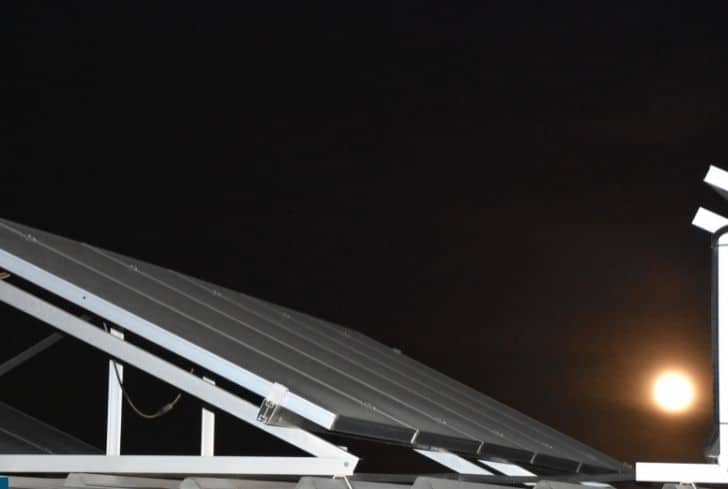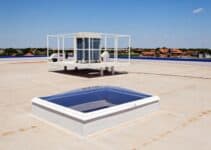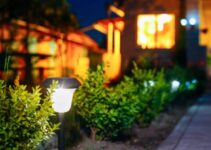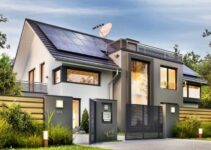Solar panels can help you save up to $1,000 in your annual energy bills. Many homeowners are taking advantage of this sustainable technology, but the photovoltaic cells work with sunlight.
So, what happens at nighttime? Do solar panels work in the moonlight? Does the moon give off solar energy? These questions will cross your mind, and this article will answer them. Dive in!
Can The Moon Power Solar Panels?
The moon is one of the earth’s most important light sources for human beings. It illuminates the way at night, but it’s an unsuitable source for charging solar panels. This is because it’s incapable of producing photons independently, unlike the sun.
Solar panels need solar energy to provide energy for your property. But it’s no secret that the amount of sunlight we receive varies throughout the year.
Can the moon power solar panels? Well, the short answer is mostly no. Solar panels require 1,450 watt-hours for an efficient charge cycle, and the sun supplies 1,368 watts per square meter. In contrast, the moon supplies approximately 2.3 million times less energy than sunlight radiation. This is barely efficient enough to satisfy the photovoltaic cells.
Does The Moon Give Off Solar Energy?
We’ll say yes; the moon also supplies solar energy. However, it’s barely strong enough to satisfy the photovoltaic cells, which are embedded components that convert energy into electricity.
Lunar radiation is essentially a reflection of the sunlight since the moon lacks a light source. Some of this energy can be captured on solar panels, but they’re not robust enough to keep the power on.
The sun is the most potent energy source for solar panels; it provides 1,368 watts per square meter. On the other hand, which is why the moon cannot charge your solar panels, lunar energy is just 0.0034 watts per square meter!
So, the light source that guides your path at night isn’t strong enough to power your solar panels. You’ll have to turn to other methods.
Can a Full Moon Power a Solar Panel?
Homeowners and business owners rely on solar energy to power many heft appliances. However, the sun may not always be sufficient to charge the photovoltaic cells, so we seek alternatives.
For instance, the moon or lunar radiation – can it power a solar panel? Well, the direct answer is no.
Regardless of the moon’s fullness, this energy source cannot still produce its light. It reflects sunbeams, but they’re not potent enough to charge solar cells, even on a full moon.
On a full moon, the light that reaches the earth is 0.3 percent of what we experience during the day in direct sunlight.
Simply put – if your solar panels produce three hundred watts of energy when the sun is out, they’ll generate one watt, give or take, when there’s a full moon.
At night, Solar inverters may deactivate themselves when lunar radiation is insufficient to power their system; they enter sleep mode because of the tiny energy.
Moreover, a sure-fire solution to this problem is to purchase an excellent solar battery; some property owners buy batteries that are strong enough to power their home or business without relying on a utility company.
Invest in an inverter with a powerful battery capacity that can store extra energy that you can use later. Another option is net metering, a credit your utility company gives you for all the extra energy your home supplies the grid. This happens when your solar panels receive adequate sunlight and have excess; use them to earn energy credits.
Why Moonlight Isn’t as Efficient as Sunlight?
The moon is naturally incapable of producing its light, but it reflects the sun. So, you may wonder why moonlight isn’t as efficient as sunlight; since they’re the same thing, why can’t lunar radiation power or charge your solar panels?
Well, to start with, sunlight is the electromagnetic radiation the sun emits. On the other hand, the moon is like a mirror or a reflector. It has a large surface that accepts the sun’s rays and directs them to earth.
However, the moon isn’t reflective enough to supply the potency or originality of electromagnetic radiation – the sun is hundreds of thousands brighter than lunar radiation. Perhaps if the surface were larger or more radiant, it would be capable of reflecting all 130,000 lux the sun sends its way.
The moon emits 0.05 to 0.1 lux, barely enough to do anything. The photovoltaic cells cannot efficiently convert this energy into anything, so the solar system will likely go into rest mode.
Essentially, moonlight isn’t as efficient as sunlight because it’s just a poor reflection of sunbeams.
Do Solar Panels Work Under Street Lights?
When installing a solar energy source in your home, it’s best to put some things at the back of your mind. For instance, how do you intend to charge the solar panels, especially when the sun doesn’t come out as much?
We’ve dealt with using lunar radiation to charge them; another consideration is street lights. It’s one of the artificial light sources, and if it’s bright enough to light our paths at night, can it also charge solar cells?
Well, solar panels may work under street lights. And to understand why the answer depends, you must get familiar with photovoltaic cells and how they work.
Solar cells are embedded components that convert sunlight into electrical currents for later use.
However, they can only convert a specific type of energy – UV radiation and infrared light won’t provide what the solar cells need. Instead, you need a light source that falls within spectrums of violet to red. The ideal wavelengths are between 380nm to 750nm, but it doesn’t have to be natural light alone.
Now, can street lights provide that energy intensity and the required environment for electrical energy to be generated? Well, if they’re LED street lights that give the needed wavelength intensity, then why not?
But if they’re average public lighting systems, they may be incapable of releasing the spectrum that provides the required energy. Consider grow lights like induction lighting, high-intensity discharge grow lights, and fluorescent grow lights.
Can Solar Panels Work With Artificial Light?
It’s a no-brainer that sunlight isn’t always available, and even though we’ve succeeded at creating technology that stores sunlight for later use, the capacity isn’t always up to par. So, it’s only natural to consider alternative ways to charge our solar panels.
Research has shown that solar panels work even without access to solar radiation, provided a potent power source is provided. However, it’s less efficient because the sun is the most vital energy source.
The electricity conversion rate depends on the photovoltaic cells’ access to artificial lights and how potent the source is. Factors like the temperature of the energy source also matter, alongside the type of bulb that’s being used.
To get the best from this sustainable investment, installing solar panels directly in sunlight is best. But since that’s not always possible, artificial light is an ideal alternative.
When fiber is heated in transparent glass in a pre-conditioned environment, artificial light is produced. And it can be potent enough to power your solar system.
However, you’ll likely experience less efficiency and fewer hours of use. And the type you’re using also determines the productivity rate for the photovoltaic cells.
The difference between sunlight and artificial light is that the former has a broader spectrum, with higher wavelengths than the latter. Sun radiation offers between 250nm to 30000nm, significantly more than what artificial options provide.
Artificial light can’t produce the same output as the sun, offering about 300nm to 800nm. That may be sufficient to power solar systems, but there’ll be an apparent decline in productivity. This is due to the variations in intensity, the type of light, and wavelength.
Can Solar Panels Work Without Direct Sunlight?
And since the moonlight is out of the question, our next best bet is artificial fixtures. Solar panels can work with artificial light, and studies have proven how it works. But again, a solar panel’s efficiency is determined by its capacity to convert photons into power.
The sun is our solar energy source, releasing massive amounts of energy every second. Hydrogen and helium gases are responsible for this, alongside nuclear fusion. During the process, however, the helium atoms lose some matter.
And the lost substance is released as radiation, but only a tiny portion actually hits the earth. But again, that little energy is just enough to power many of our applications.
Essentially, solar cells don’t need sunlight for electricity, provided there’s daylight, with ample photons that can be absorbed.
How Much Solar Does the Moon Reflect?
The moon is a reflective surface that directs sunlight to earth at night. However, its surface is just large enough to reflect one-fourth of the sun’s energy on the planet. The moon lacks heat and air; since there’s no atmosphere, it cannot turn the radiation into infrared thermal emissions or bounce-back waves.
Will Solar Panels Charge With a Flashlight?
Well, the short answer is yes, but mostly no. It would have to be a massive one to charge your solar panels with a flashlight. And this technique goes against the conservation of energy.
The batteries will run out long before they’ve supplied the solar cells with enough photons to power your property. In essence, it’s a wasted effort. Flashlights generate too little energy to make any difference.
Can I Use a Solar Panel With UV Light?
You cannot power your solar system with a UV bulb because the wavelength it produces is too insignificant and inefficient.
Can I Use my Solar Panel With Indirect Sunlight?
You can also use indirect sunlight to charge solar panels. It’s not uncommon for commercial users of this sustainable technology to employ large rotating mirrors that track the sun’s movements.
Then, they redirect the radiation into the solar panels while the sun shines.
How to Get the Best Out of Your Solar Panels?
Sunlight won’t always be your friend, even when you rely on solar technology. However, there are some tips and tricks for getting the best out of the panels:
Install them at the Proper Angle
Installing your solar panels are the correct angle ensures that they have adequate access to sunlight and are free from obstructions. The more exposed the glass surface is to sunlight, the better the charge strength.
Clean the Panels Regularly
An accumulation of grime, dust, and other pollution will negatively affect your solar panels’ access to sunlight. So, you must clean them regularly to prevent debris buildup.
Conclusion
Solar energy is undeniably a potent energy source for the earth. It powers a significant amount of our daily activities, and the solar system is technology’s way of making this energy source constantly available.
However, sunlight is less robust at specific periods yearly; what are homeowners who rely on solar energy to do then? We’ve explored your options in this article and trust that you’ll make informed decisions going further.






